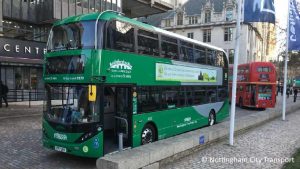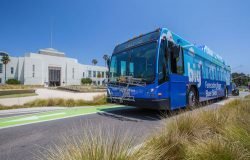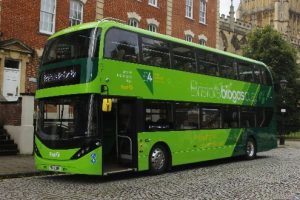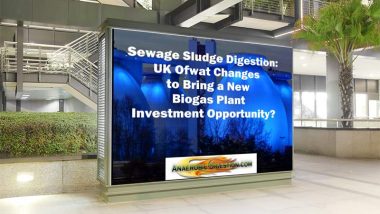Biogas buses are catching on.
What could be better than using biogas from the anaerobic digestion process to power transport fleets? The energy source is renewable, made from waste by-products, and the methane used in this fuel is clean-burning. Using it instead of using a fossil fuel like diesel removes the concerns for air pollution which come from using diesel to power trucks and buses.
Add to this that most governments charge a far vehicle duty (tax rate) for using it than oil and petrol (gasoline).
What Exactly is a Biogas Bus?
 Biogas which has first been purified to just be methane (known as biomethane) is now utilised in compressed form (known as Renewable Natural Gas – RNG) to fuel city buses, autos, and heavy goods transport vehicles (HGVs).
Biogas which has first been purified to just be methane (known as biomethane) is now utilised in compressed form (known as Renewable Natural Gas – RNG) to fuel city buses, autos, and heavy goods transport vehicles (HGVs).
These buses have an engine, not unlike a diesel engine, but it is designed to run on compressed biomethane.
There are two forms of compression. The first is the degree of compression used for the natural gas provided in the gas grid, and the second is a higher compression pressure sufficient to liquefy the compressed gas which is LNG, or liquified natural gas.
This has all been made possible in recent years, using technology that has been developed to chill biogas to roughly minus 160 degrees Celsius. At this temperature, it becomes a liquid and hence more energy-dense when stored at pressure.
This has also opened up the option of employing the gas for heavy transport, both on land and at sea. As city air pollution has to be reduced the fuel is increasingly being adopted for buses.
What is Renewable Natural Gas?
Biogas that is pipeline-quality or “transportation fuel quality” is known as renewable natural gas (RNG), because it is essentially the same methane purity and calorific value as natural gas and is interchangeable with it when used.
The main sources of RNG are:
- methane recovered from landfills,
- farm digesters, and wastewater treatment plants.
RNG is made from non-fossil, organic waste sources and is 100% compatible with geologic natural gas. It can be used as a drop-in blend or as a full replacement. When compared to diesel, RNG produces a 70% – 130% reduction in emissions over its lifetime.
The technology, the cost savings, and the infrastructure for fueling are all now accessible.
There's no need to wait for better, cheaper batteries or infrastructure for electric or hydrogen fueling.
The US Environmental Protection Agency has confirmed that the biogas from landfills, dairy farms, and wastewater treatment plants that would otherwise be discharged into the atmosphere is collected and processed to make RNG.
Why are Bio-Gas Buses so Fantastic?
The need breed of brand new bio-gas buses are the greenest buses on the road, and they will significantly reduce our carbon footprint while also improving air quality.

Liquid biogas has several advantages, including the fact that it is fossil-free, renewable, locally generated, and cuts emissions, including greenhouse gas emission reduction.
Operators lower their own and their customers' climate effect by more than 90% by converting to locally generated liquid biogas as fuel in long-distance trucks or buses.
Reduced particle and nitrogen oxide (NOx) emissions improve air quality in general, and these quieter running vehicles benefit both drivers and passengers, as well as society as a whole.
Are Biogas Buses as Environmentally Friendly as they Claim?
 First and foremost, they are unquestionably green in terms of harmful emissions. That's before you even consider the carbon emissions savings.
First and foremost, they are unquestionably green in terms of harmful emissions. That's before you even consider the carbon emissions savings.
Biogas is a considerably more environmentally friendly fuel to generate and consume than diesel. These buses produce very little particulate matter (soot) or hydrocarbons. Using bio-gas buses saves 84% on CO2 emissions and produces cleaner tailpipe emissions than a comparable Euro 6 double-deck bus.
The availability of biogas will rapidly improve throughout Europe, especially now that the EU has chosen to install fueling stations along with major European road networks (TEN-T).
“As the first long-distance biogas coach, this is undoubtedly the most sustainable coach option available today,” says Johan Ekberg, Head of Scania's Customer Unit.
“Biogas is not just the lowest-emitting fuel; it also solves local waste problems, provides local jobs, and returns carbon and nutrients to the land. It is the circular economy's Swiss Army Knife “Scania's Sustainability Director, Jonas Strömberg, agrees.
Are biogas buses less expensive to operate?

Gas is a somewhat cheaper fuel than diesel, but biogas buses are more expensive to produce. The fuel savings are countered by the high cost of the buses and the Gas Station needed to fuel them.
In 2015, biogas already accounted for almost 10% of Europe's gas grid, and its use is fast increasing, actively contributing to CO2 emission reductions. Biogas accounts for 95% of the car gas grid in Sweden.
“Biogas will be one of the most important methods for decarbonizing heavy-duty transportation, particularly for long-distance operations such as intercity and long-haulage. By 2025, biogas may power half of Europe's heavy-duty gas fleet “Jonas Strömberg wraps things up.

On This Page
- Diesel Vs Natural Gas as CNG and LNG
- Partnerships between the City of Hamilton, Enbridge Gas and StormFisher
- Biogas from Livestock Operations
- Biogas from Wastewater Treatment
- Biogas Use for Transport in Sweden
- US CNG and RNG Use Hits High
- Compressed Natural Gas (CNG) Buses
- Electric vs. Diesel vs. Natural Gas
- Biogas Buses Conclusion
Diesel Vs Natural Gas as CNG and LNG
In the approaching years, diversification of road transport fuels will be a significant attribute for road transport. Biogas is a popular sustainable fuel source.
As a transition technology, there are clear benefits for fleet managers to move to natural gas to fuel their vehicles. Natural gas is a low emissions fuel from the point of view of pollution. This is very important in cities with city centres now being classed as no-go areas for diesel vehicles due to air quality requirements.
On a CNG vehicle, the fuel is stored onboard as either CNG or LNG. In either case, it is fed to a re-tuned modified standard spark-ignition type engine. Because methane is a small molecule that burns cleanly, natural gas vehicles have much simpler and cheaper after treatment/ exhaust systems than diesel.
A rising number of companies are now starting to transition their diesel fleets to cleaner, low-carbon fuel but for many organisations making that move, it is clear that merely to convert to natural gas makes little point.
If they can buy RNG instead which is renewable they can help the entire organisation in their net-zero goals by showing immediate and substantially reduced company carbon footprint. RNG made from the organic fraction of Municipal Solid Waste and from landfill gas is the first renewable and commercially available vehicle fuel made entirely from organic waste.
RNG Partnership between the City of Hamilton, Enbridge Gas and StormFisher
Transit users can now catch a carbon-negative ride on Ontario's first bus fueled by renewable natural gas (RNG). The rng public transit bus hit the road today in Hamilton, in the Golden Horseshoe Region of Southern Ontario that’s one of North America's fastest-growing regions.
It runs on RNG, a cost-effective, low-carbon alternative to diesel fuel, which is supplied by Enbridge Gas Inc. And created in the nearby city of London at the Stormfisher biogas facility that processes organic waste.
RNG produced at the Stormfisher plant is considered carbon negative because it’s diverting organic waste from a landfill and prevents methane from being released into the atmosphere.
“Renewable natural gas provides an excellent opportunity for the HSR (Hamilton Street Railway, the city’s transit authority) and City of Hamilton to continue our efforts to lower corporate GHG emissions. This means that they have been able to move toward targets outlined in their climate change emergency declaration and corporate energy and sustainability policy,”
said Hamilton Mayor Fred Eisenberger. Plus;
“We are proud to partner with Enbridge Gas on this innovative initiative that will pave the way to ensure the future of transit in our community is energy efficient and sustainable.”
This green HSR bus operates with carbon-negative RNG fuel that goes beyond net-zero. Moreover, Stormfisher’s facility in London, Ontario, provides the RNG creating a circular economy in the province.
This project also helps the community achieve its climate change targets, divert waste from landfills, and support economic development.
Biogas from Livestock Operations
Biogas recovery systems at livestock operations can be used to produce renewable natural gas. Animal manure is collected and delivered to an anaerobic digester to stabilize and optimize methane production.
The resulting biogas can be processed into RNG and used to fuel natural gas vehicles. As of August 2017, there were about 250 anaerobic digester systems operating at commercial livestock farms in the United States.
Most of these facilities use biogas for electricity generation. A few farms are using biogas to produce the transportation fuel, including Hilarides Dairy in California and Fair Oaks Dairy in Indiana. The US EPA's Agstar database provides more information about the use of such systems in the United States.
Biogas from Wastewater Treatment
Passengers can travel the routes Brussels-Amsterdam and Stockholm-Oslo in a particularly climate-friendly way on buses powered by biogas.
Atmosfair has supported Flixbus in sourcing biogas for pilot projects to ensure that the buses operate as sustainably and climate-friendly as possible.
The pilot project in the Benelux region is in cooperation with bus manufacturer Iveco and gas company OG (Orangegas).
The biomethane or CBG (compressed biogas) powering the bus, is produced from sewage sludge in a plant in Amsterdam Westpoort.
A product of wastewater treatment, sewage sludge, it is a very sustainable feedstock for biogas production from an ecological point of view.
Biogas Use for Transport in Sweden
Biogas buses and biogas powered trucks are catching on in a big way in Sweden, even if most fleets will be LNG fuelled they will later be converted easily to biogas as more becomes available.
RNG will be supplied from fossil fuel sources by definition, but for now, LNG is certainly much better than diesel power.
The energy source is renewable, usually made from waste by-products, the methane used in this fuel is clean-burning, and removes the concerns for air pollution which come from using diesel to power trucks and buses.
in the year 2005, Sweden became the first country in the world to have a biogas powered train. The development of this energy-saving transportation came after a European Directive urging governments to promote biofuels and other renewable energy sources for transportation as replacements for petrol and diesel.
The use of RNG increases and diversifies domestic energy production. RNG can be used as a baseload fuel source with high availability rates. It leverages existing infrastructure such as pipelines and heavy-duty vehicles. Biogas feedstocks for rng are generated continuously from a variety of sources.
Sweden has currently the highest share of energy from renewable sources in transport with nearly 30%.
For several years, Sweden has been putting the use of biogas and biomethane as green fuels in the forefront to achieve its goal, thanks to policies for NGV and BioNGV, major investments to boost the market, subsidies and tax exemptions for those choosing this type of fuel.
US CNG and RNG Use Hits High
In 2018, renewable natural gas (RNG) on-road fuel use reached a historic high.
Of the 645 million gasoline gallon equivalent of natural gas used as a motor fuel last year, more than 204 million gasoline gallon equivalent was renewable—equating to 32%.
In states with a low carbon fuel standard program in place, like California, that figure is well over 90%.
And an increasing number of natural gas fuelers are pledging to dispense 100% RNG at their stations within the next decade as more and more biomethane becomes available and new production facilities come online.
Compressed Natural Gas (CNG) Buses Will Transition to RNG Use
Los Angeles County Metropolitan Transportation Authority (Metro) voted to replace 1,000 ageing diesel buses with a combination of new compressed natural gas (CNG) models fueled by renewable natural gas and electric buses.
Because of their immediate availability, affordability and “cleaner-than electric’” characteristics, 800 of the new busses would be fueled by renewable natural gas. Because electric models are exponentially more expensive and because electric bus technology is still unproven and unreliable over long-distance routes such as those serviced by L. A. Metro, the remaining 200 are slated to be electric — to serve as a test program for future electrification of the transit agency.
CNG is compressed natural gas, which is currently considered the most cost-effective alternative to petrol and diesel, while at the same time bearing the potential to significantly reduce CO2 emissions. CNG is primarily made up of methane, which is compressed in order to reduce the volume and increase the energy density. Usually, CNG is transported to filling stations in gas pipelines or in special trucks.
Renewable natural gas is a drop-in replacement that provides an ultra-low emission, carbon-negative solution, this time for a compressed natural gas engine. RNG is essentially biogas (the gaseous product of the decomposition of organic matter) that has been processed to the required purity standards, according to the Department of Energy.
Nearly 90% of surveyed fleets that have CNG vehicles intend to use RNG in the next year, the highest rate of any renewable fuel or energy source across all drivetrains, according to the state of sustainable fleets report published by Gladstein, Neandross & Associates.
Examples of Fleets Converting to Renewable Methane
The Big Blue Bus has always maintained a fleet of buses that represents the latest in bus technology and cleanest fuel sources. As part of this commitment, Big Blue Bus reached a significant milestone in 2014, becoming the first transit agency in Southern California to purchase buses with near-zero compressed natural gas (CNG) engines.
Cherriots buses are powered by renewable natural gas. More than half of Cherriots buses now get their fuel from landfills. In December last year, the transit provider for the Salem Area switched the fuel source for 34 buses from compressed natural gas to renewable natural gas. The two fuels are nearly identical chemically and riders likely didn’t notice any change.
Big Blue Bus (BBB) is operating a fleet of 200 vehicles that transport 13. 3 million passengers annually.
For the first time, six San Diego area fueling stations will start supplying trucks and buses with renewable natural gas (also known as biogas). Through a pilot program, the low-carbon, clean-air fuel will be available at SDG&E’s compressed natural gas (CNG) stations in Miramar, Kearny Mesa and Carlsbad, as well as at three private stations.
The City of Pasadena has entered into a multi-year rng supply agreement for an anticipated 1. 5 million gallons to fuel their fleet of over 50 CNG refuse and transit buses.
CPS Energy in San Antonio, Texas, has signed a deal to provide renewable natural gas (RNG) to the city’s mass transit provider. Under the deal, the public power utility would provide the gas, which will be produced from landfill biogas, to via metropolitan transit beginning in 2021. The transit agency will use the gas in its fleet of 502 buses, which are now powered primarily by compressed natural gas (CNG) along with some diesel-electric hybrid, electric, diesel, and propane-fueled vehicles.
Redeem is the first commercially available, renewable natural gas vehicle fuel. It is derived entirely from organic waste sources and is available as compressed natural gas (CNG) or liquefied natural gas (LNG). Redeem is produced from renewable natural gas production facilities owned and operated by clean energy and from third-party producers.
Lille, Northern France, prides itself on having the largest fleet of natural gas buses in Europe. More specifically their biomethane comes from household waste. Iveco Bus and the transport operator Keolis are the main actors in the project.
The growth of a robust RNG sector in Canada and North America indicates now is the time to take a new look at this robust technology. Proven vehicle designs, commercial experience, and long-term operational data serve as evidence of the cost savings and benefits of natural gas vehicles over diesel comparables. Today, natural gas vehicles can achieve zero and even net-negative emissions if their fuel source comes from renewable sources rather than traditional and unconventional natural gas supply chains.
In 2019. Translink and FortisBC announced a partnership that will RNG for TransLink's natural gas bus fleet. Translink was the first public transportation authority in Canada to use RNG, a certified carbon-neutral fuel, to help fuel its natural-gas-powered buses.
Bristol community transport is Bristol’s largest transport operator and a part of the transport social enterprise HCT Group. As a social enterprise, it reinvests profits from the commercial operations into furthering transport services for the communities that they serve. The two other Metrobus routes operated by First West of England, which already has biogas (renewable natural gas) buses in operation in the Bristol area, of England.
Electric vs. Diesel vs. Natural Gas: Which Bus is Best for the Climate?
Battery electric buses typically cost about $800,000, compared with $525,000 for a natural gas bus and less than $500,000 for a diesel bus. Fuel cell buses currently cost about $1. 3 million. But electric bus advocates counter by citing the higher cost of natural gas. Fueling a natural gas bus costs about $27,000 annually, compared with $10,500 in electricity cost for an electric bus, according to sources.
Everywhere in the country, battery-electric buses also have lower life cycle global warming emissions than natural gas and diesel-hybrid buses. Charged with the national electricity mix, an electric bus produces 1,078 grams co2e per mile, while a natural gas bus produces 2,364 grams co2e per mile and a diesel-hybrid produces 2,212 grams co2e per mile.
Buses need to perform – no question about it. Routes are optimized to ensure timely pick-up/drop-off for students. Downtime isn’t an option. Thankfully, natural gas vehicle technology has proven itself within the bus market. Drivers will appreciate power and range similar to diesel vehicles.
This is incredibly important as fleets weigh out alternative vehicle technologies – electric buses are attractive for some, but at this point, feature battery ranges far less than natural gas or diesel buses. Although incentives may be in place to offset the high cost of EV buses and therefore grab the attention of many, districts need to consider the entire vehicle experience, as they may end up needing more buses to accomplish the same task.
A city with a fleet of 100 CNG buses can realize at least $25 million in fuel savings by switching from diesel to natural gas buses, and with lower maintenance costs as they don’t have to deal with problematic diesel particulate traps and associated def.
Many school buses in one US county are electrified with battery-electric drivetrains. The rest of the school bus stock is fueled equally by RNG and 100% renewable diesel (r100 or renewable hydrogenation-derived renewable diesel). While renewable diesel does not have the air quality benefits of other energy sources, it allows deep decarbonization with existing diesel drivetrains.
Use of biogas for city buses will lower emissions and substitute fossil fuels. It will strengthen the role of public transport as an efficient strategy to limit the impact from traffic on climate change. Biogas can be produced from biodegradable materials (waste, manure, sewage sludge and landfill gas) thereby creating energy autonomy and jobs.
Through purification, it reaches the same quality and characteristics as natural gas (methane) and can be used as fuel for vehicles. Biogas buses have a much lower impact on inner-city air quality and lower noise levels than comparable diesel buses. Hybrid electric technology enhances the energy efficiency and versatility of biogas buses even further.
Extended use of biogas for city buses will lower emissions, improve inner-city air quality and strengthen the role of public transport in an efficient strategy to limit the impact of traffic on climate change.
Biogas Buses Conclusion
Passengers, drivers, and the community at large appreciate quiet-running natural gas buses. Most operators investing in natural gas buses plan to use RNG to fuel them.
Captured above ground from organic material in agricultural, wastewater, landfill, or food waste, RNG can produce carbon-negative results when fueling on-road vehicles like short and long-haul trucks, transit buses, and refuse and recycling collection vehicles.
The California Air Resources Board’s Q3 2020 data confirms that the energy weighted Carbon Intensity (CI) value of California's RNG vehicle fuel portfolio in its low carbon fuel standard (LCFS) program is carbon negative and below zero at -17.
RNG vehicles significantly reduce vehicle emissions, decrease operating costs, and allow transportation agencies to carry out planned service enhancements. The RNG fuelled transport sector is a rapidly growing success. Long live biogas buses!





